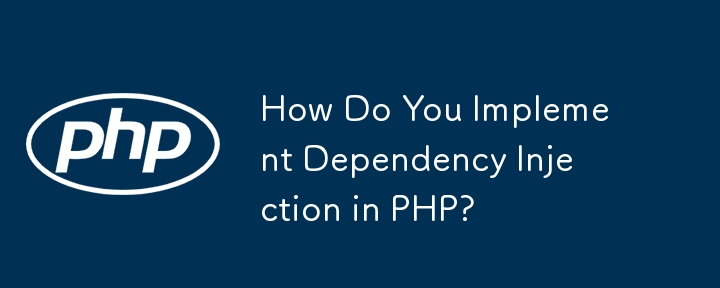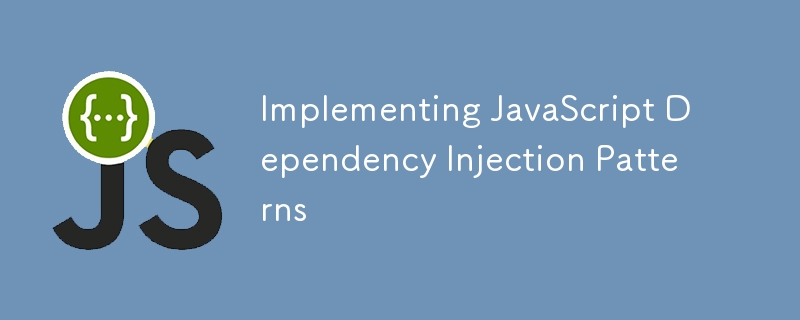
Course Introduction:The reason for using Dependency Injection (DI) is that it promotes loose coupling, testability, and maintainability of the code. 1) Use constructor to inject dependencies, 2) Avoid using service locators, 3) Use dependency injection containers to manage dependencies, 4) Improve testability through injecting dependencies, 5) Avoid over-injection dependencies, 6) Consider the impact of DI on performance.
2025-05-08 comment 0 1051

Course Introduction:Dependency injection (DI) is a way in PHP to pass dependencies to a class rather than hard-coded inside a class. 1. DI passes the dependencies of the object to the outside through constructors or settings methods to improve code flexibility and testability; 2. DI can be implemented manually, suitable for small projects; 3. Complex applications can use DI containers to automatically resolve dependencies, such as Symfony and Laravel built-in containers; 4. Common misunderstandings include premature over-design, type prompts specific implementation rather than interfaces, abuse of service locators, etc. Correct use of DI can significantly improve code quality and maintenance efficiency.
2025-07-18 comment 0 824

Course Introduction:Service containers are the core tool for Laravel to manage dependencies and perform dependency injection. They reduce coupling by automatically parsing dependencies and improve code testability and flexibility. 1. It is like a "factory", which automatically creates objects and manages its life cycle; 2. Binding is used to tell the container how to create class instances. Common methods include bind() (new every time), singleton() (singleton) and instance() (existing instances); 3. Common usage scenarios include interface and implementation binding, singleton binding shared resources, and conditional binding switching implementation; 4. It is not recommended to over-binding to keep the code concise and clear. Mastering service containers helps write more flexible and maintainable Laravel applications.
2025-07-23 comment 0 226

Course Introduction:Dependency injection is useful in JavaScript because it improves testability, maintainability, and decoupling. 1. Constructor injection passes dependencies through constructors, which are suitable for class structures and are clear and easy to measure; 2. Method injection passes dependencies as method parameters, suitable for situations where dependencies are only needed in specific methods; 3. Use IoC containers such as InversifyJS or custom containers to manage dependencies uniformly, suitable for complex projects. Practical recommendations include avoiding hard-coded dependencies, keeping constructors concise, using clear naming and prioritizing interface abstraction, thereby improving code flexibility and modularity.
2025-07-18 comment 0 997

Course Introduction:In Laravel, "binding" refers to the parsing method of registering classes, interfaces or services through the service container to achieve automatic dependency injection. The essence of binding is to define how to create or obtain an instance of a dependency, rather than simple storage. Common types include simple binding, interface-to-implementation binding, and singleton binding. Binding should be performed in the service provider's register() method, which is suitable for situations where switching implementations, complex construction parameters, or third-party class injection, but problems such as excessive use or uncleared binding cache should be avoided.
2025-07-16 comment 0 902

Course Elementary 13888
Course Introduction:Scala Tutorial Scala is a multi-paradigm programming language, designed to integrate various features of object-oriented programming and functional programming.

Course Elementary 82443
Course Introduction:"CSS Online Manual" is the official CSS online reference manual. This CSS online development manual contains various CSS properties, definitions, usage methods, example operations, etc. It is an indispensable online query manual for WEB programming learners and developers! CSS: Cascading Style Sheets (English full name: Cascading Style Sheets) is an application used to express HTML (Standard Universal Markup Language).

Course Elementary 13237
Course Introduction:SVG is a markup language for vector graphics in HTML5. It maintains powerful drawing capabilities and at the same time has a very high-end interface to operate graphics by directly operating Dom nodes. This "SVG Tutorial" is intended to allow students to master the SVG language and some of its corresponding APIs, combined with the knowledge of 2D drawing, so that students can render and control complex graphics on the page.

Course Elementary 24695
Course Introduction:In the "AngularJS Chinese Reference Manual", AngularJS extends HTML with new attributes and expressions. AngularJS can build a single page application (SPAs: Single Page Applications). AngularJS is very easy to learn.

Course Elementary 27539
Course Introduction:Go is a new language, a concurrent, garbage-collected, fast-compiled language. It can compile a large Go program in a few seconds on a single computer. Go provides a model for software construction that makes dependency analysis easier and avoids most C-style include files and library headers. Go is a statically typed language, and its type system has no hierarchy. Therefore users do not need to spend time defining relationships between types, which feels more lightweight than typical object-oriented languages. Go is a completely garbage-collected language and provides basic support for concurrent execution and communication. By its design, Go is intended to provide a method for constructing system software on multi-core machines.
Laravel Modal does not return data
2024-03-29 10:31:31 0 1 659
Can I use the automatic generation module of thinkphp5 in Windows 7 system? How to configure and use
2017-10-10 17:04:14 0 2 1448
2017-10-10 19:25:59 0 4 3008
To use mcrypt_get_key_size() in php study, how to enable mcrypt_
2017-10-10 19:47:34 0 1 1230
Detecting login status and preventing repeated login status in TP5 - My page is wrong
2017-10-10 22:49:15 0 0 1251